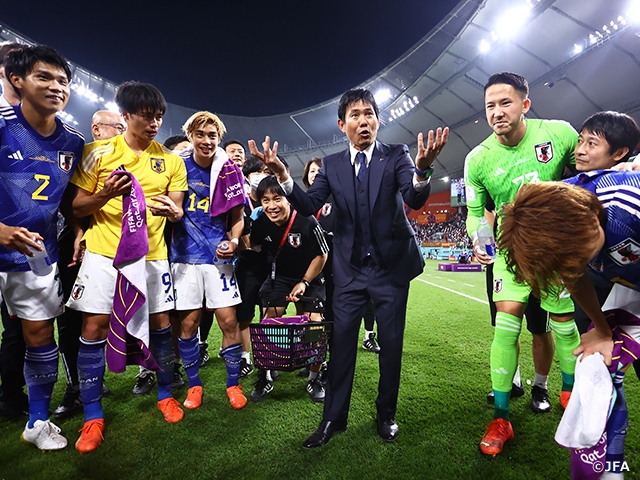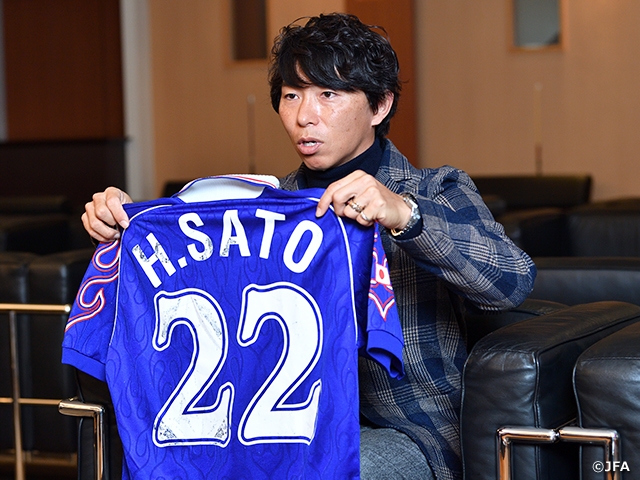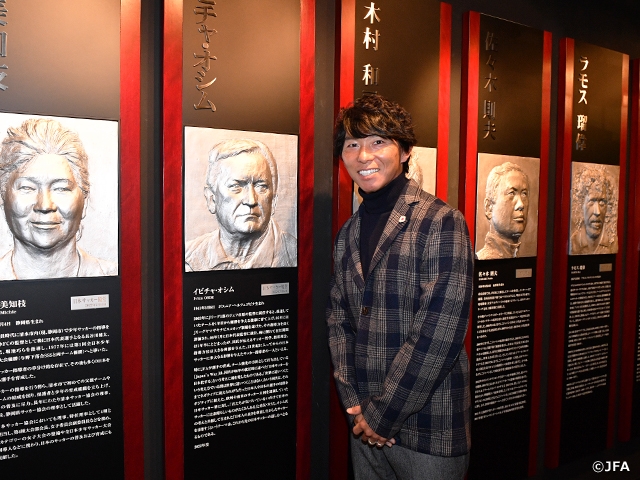NEWS
【Japan Football Museum】”We have to pass on the passion of many people” Interview with Mr. SATO Hisato
05 January 2023

The Japan Football Museum will be closed on Sunday 5 February 2023 due to the relocation of the Japan Football Association (JFA) office. Here, we interviewed Mr SATO Hisato, who attended the Japan Football Museum talk event held on Sunday 25 December 2022, about memorable tournaments and his impressions of the museum.
――How do you assess the performance of the SAMURAI BLUE (Japan National Team) at the FIFA World Cup Qatar 2022™?
SATO The preparation period was shorter than the previous World Cups, so it must have been very challenging to strengthen the team. I believe there was a mix of optimism and anxiety, but the team delivered on what they had planned as a unit to achieve outstanding results in that challenging group. I believe that the effort put forth by Head Coach MORIYASU Hajime to “increase the possibility of winning by 1%” has come to fruition, and they showed great composure to contain their opponents at all times.

――What was your impression of the whole tournament?
SATO I thought there was a huge difference in quality from the top-level players of the word, and I wanted to see what Japan could do against such opponents. This time, I was able to watch 16 matches in Qatar, and even with a single pass, for example, the difference between whether it goes 30 centimetres forward or backward can alter the speed of the subsequent play and the position of the opponent's defence, and I felt that that is the kind of detail and quality we need to pursue from now on.
――What kind of person is Coach Moriyasu, whom you have a close relationship with from your time at Vegalta Sendai and Sanfrecce Hiroshima?
SATO I think the person you see on camera is the real Moriyasu-san. He isn't two-faced, he doesn't pretend or say things to make himself look bigger than he is. He is good at working steadily, and I think he has adopted various concepts as he gained experience as a coach for clubs and the national team, but his philosophy and the way he deals with people have not changed. What struck me was that in the interview after the win over Spain, he said something like “this victory was won by everyone,” which sounded very similar to the words he used when we won the championship for the first time in Hiroshima. My wife, who was listening to the interview with me, also said the same thing, and I thought it was very typical of Moriyasu-san.
――Are there any particularly memorable World Cups from the past?
SATO The “Agony of Doha” in 1993 left a strong impression on me. I was in sixth grade at the time and stayed up late to watch it. I remember going to bed crying because it felt like I was being confronted with the reality that we cannot reach the World Cup, despite the presence of star players such as Kazu-san (MIURA Kazuyoshi), Gon-san (NAKAYAMA Masashi) and Ramos-san (RAMOS Ruy). In terms of World Cups that the Japan National Team has participated in, the 1998 FIFA World Cup France™ left a deep impression on me. While we had high hopes for our first World Cup appearance, we also felt the difficulty of scoring goals, getting points, and winning matches at the world stage. At the time, I myself was representing Japan as a member of the U-16 Japan National Team for the first time and felt the difference between Japan and the rest of the world, so that was also part of the reason why it left such an impression on me.
――Can you tell us about a particularly impressive match or player?
SATO The movements of Gabriel BATISTUTA (Argentina National Team) were summarised in the technical report prepared by Technical Director ONO Takeshi (at the time). Although he is a player well known for his dynamic plays, the report described how he moved and made spaces in order to produce such dynamic plays and score goals. It was right around the time when I myself first joined the national team, so it gave me an opportunity to seriously think about what I needed to do to score goals.
――You have brought with you a jersey from that period.
SATO This is the jersey we wore when we played the AFC U-16 Championship in Doha, Qatar. It is the same design as the jersey worn in the “Delight of Johor Bahru” in 1997 and the 1998 FIFA World Cup France™. Now that the World Cup has been held in Qatar, I thought I had the jersey I wore in Doha in 1998 somewhere, so I looked for it and found it at my wife's parents' house for some reason. Unfortunately, we were unable to participate in that particular World Cup, however, the national team activities for the youth age group were linked to the growth of the senior national team, and I was able to advance as a player through the numerous tours we undertook and by experiencing at first hand the differences with the rest of the world.

――Have you visited the Japan Football Museum before?
SATO Yes, I came in the summer of 2022. I had goosebumps as I observed the history, which was richer than I had anticipated. I used to think this place was all about the glamorous exhibitions of past generations, but I regretted why I didn't come earlier, because I could see the real history of Japanese football, something we rarely get to see on a day-to-day basis. Although it has become a norm for us to have the J.League and for the Japan National Team to play in the World Cup, this is only made possible with the tireless efforts and the passion for football of many people. As a generation that has been given so much by football, we must ensure that we pass this on to the next generation. The national team and the players have given us the joy of football and the beauty of achieving results through this World Cup, and I think it is our mission to pass this on to the future.
――The Japan Football Museum is scheduled to close on 5 February 2023 due to the relocation of the JFA office.
SATO I am sure it will be reborn in a new form, but the current museum will only be open for another month or so. I encourage people to come and visit the museum to see the history and the progress we have made over the years. I think you will be able to see why we were able to achieve what we have achieved in this World Cup, and by seeing the museum in its current state, you will be able to look forward to seeing how it will be transformed in the future. I would like everybody to visit the museum and share the history of Japanese football.

Japan Football Museum
The Japan Football Museum opened on 22 December 2003 to further develop football culture by utilising the legacy of the 2002 FIFA World Cup Korea/Japan™. Total number of visitors is approximately 700,000 (as of December 2022, annual average: approximately 36,700). The Museum will close on Sunday 5 February 2023 due to the relocation of the JFA office.
Latest News
-
National Teams
2025/11/07
U-22 Japan National Team squad & schedule - England Tour (11/9-19)

-
National Teams
2025/11/07
【Scouting Report】The “Black Stars” – Long-standing Rivals of Japan, Advance Through the African Qualifiers with Resolute Defence and Dynamic Attack - Ghana National Team

-
National Teams
2025/11/06
SAMURAI BLUE (Japan National Team) squad & schedule - KIRIN CHALLENGE CUP 2025 vs Ghana (11/14@Aichi) vs Bolivia (11/18@Tokyo)

-
National Teams
2025/11/04
U-18 Japan National Team squad & schedule - Wales Tour (11/10-20@England/Wales)

-
National Teams
2025/11/04
U-18 Japan Futsal National Team short-listed squad & schedule - Training Camp (11/9-12@JFA YUME Field)


